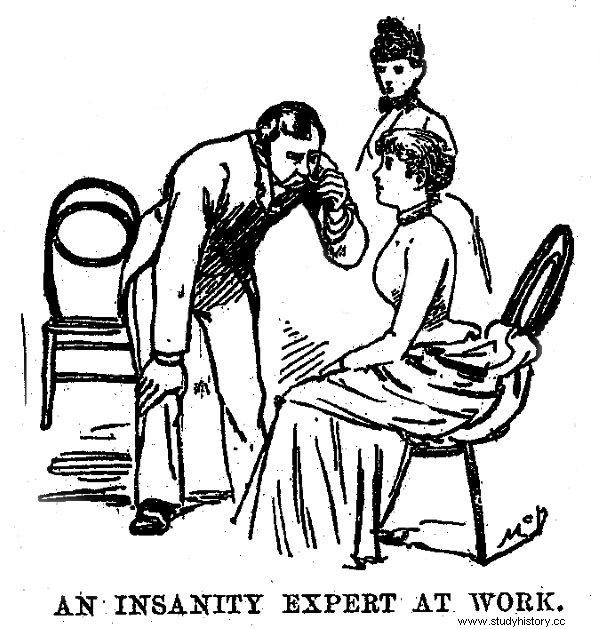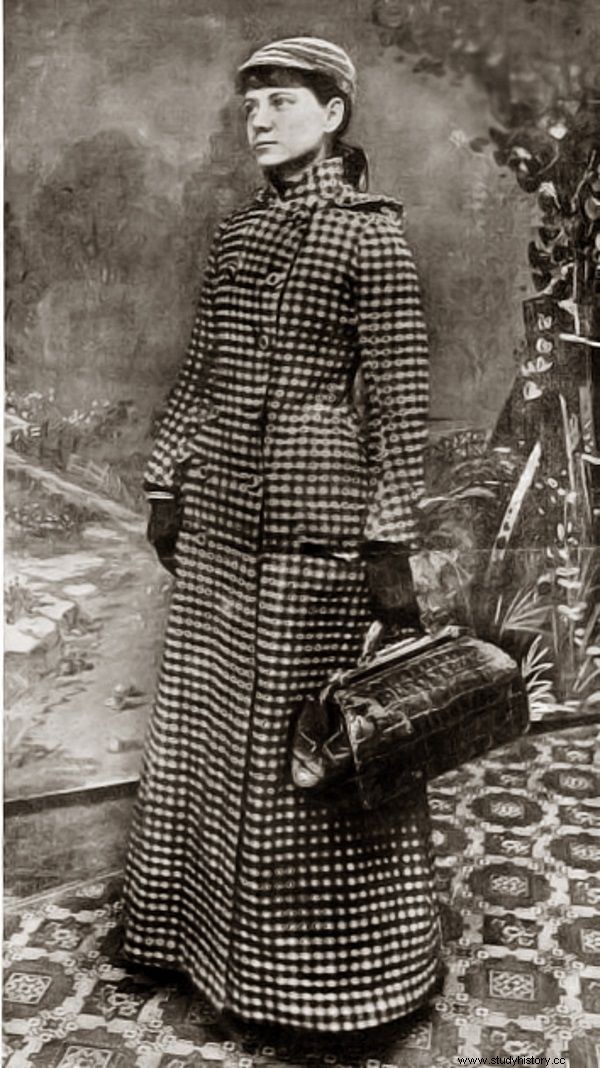In a world where cell phones, GPS and airplanes did not exist, Nellie Bly set out to prove that she would go around the globe faster than the hero of the novel "Around the World in 80 Days". Nobody believed she would succeed, meanwhile the reporter completed the trip faster than anyone before her. Today nobody remembers about this pugnacious traveler.
Elizabeth Jane Cochran was born in 1864 as one of fifteen children of Michael Cochran from the Pittsburgh area of Pennsylvania, USA:a resourceful worker who managed to save some money and buy a local mill. The girl lost her father early, and because without him there was not enough money to live, she had to abandon her dreams of a “higher-class” education. Together with her mother and siblings, she moved to the city, patting relative poverty there. In 1880, when she was 16, a sexist article appeared in a local newspaper stating that girls were only fit for childbearing and housekeeping, and that those working professionally were freaks.
The reading infuriated Miss Cochran, who had already started adding an "e" to her surname at the end (Cochrane) and had long gone to work to help her widowed mother. The girl wrote a virulent replica that impressed editor George Madden so much that he offered her a permanent job. According to the custom of the time, it was not appropriate for ladies to publish under their own name, so it was necessary to come up with a pseudonym for Elizabeth. Someone had the idea to take it from a popular song at the time. This is how Nellie Bly was born.
First investigative journalist?
As it turned out, Nellie, despite her young age, was a consummate reporter who went in a completely different direction than the overwhelming majority of women writing at the time. Instead of reporting on charity parties, elegant teas and fashion news, she wrote texts about the lives of women, especially the working ones. Miss Bly became, in a way, one of the first investigative journalists. Among other things, she described the fate of women working in Pittsburgh's factories. Very soon, Madden started getting messages from outraged plant owners. Nellie also worked for a time as a correspondent from Mexico, but when she began to protest against the imprisonment of a local journalist for criticizing the government, she had to flee the country herself so as not to end up behind bars.

Miss Bly in the insane asylum - illustration from the newspaper (photo:public domain)
However, the most interesting challenges awaited her in New York. In 1887, she quit her job in Pittsburgh and managed to join the New York World:the newspaper belonging to Joseph Pulitzer himself (the one from the famous journalist award). It was there that she was given the task of describing the lives of women confined to the hospital for insane asylums on Blackwell Island.
In order to experience what was the everyday life of the mentally ill, she allowed herself to be hospitalized in a madhouse under cover. Ten days later, she was pulled out of the hospital by her superiors from the newspaper. The journalist described the shocking conditions in which patients lived, harassment, beatings, starvation and other atrocities experienced by people who should be cared for.
However, Nellie's greatest adventure began in 1888. Then the journalist suggested to her editorial office that she would implement the crazy plan from the novel by the French writer Jules Verne "In 80 days around the world", which was first published in 1872. She intended, just like the book, Phileas Fogg, to go around the globe in no more than two and a half months. Pulitzer agreed to the escapade and decided that he would sponsor it in return for the daily reports published in his newspaper.
The journalist began her crazy journey on November 14, 1889. She took very little with her - a decent coat, a few changes of underwear, one dress, toiletries and some money. All belongings were contained in a small travel bag.
For an adventure meeting
The Pulitzer-led editorial office kept Nellie up-to-date on the map and published subsequent materials sent by her. In the pre-email world, it wasn't easy. She sent messages with the help of a telegraph or by couriers. It was a short piece of information from which the editors of the newspaper had to conjure up longer materials on the spot. Throughout the women's expedition, almost every issue featured fragments of reports from the relentless Nellie.
Two things were beyond the mind of society at that time. Firstly, that it is possible to go around the world faster than Verne predicted, and even more so because a woman would be able to accomplish this feat. Meanwhile, Miss Bly knew full well that her journey must rest on two pillars.
On the one hand, she must rush to the destination as quickly as possible, on the other, as a good reporter who wants to keep the readers interested in the expedition, she must provide them with ravishing and imaginative materials. Wherever she went, she tried to tell in detail about the customs, places worth visiting, and most of all about local residents.

Around the World with Nellie Bly (photo:public domain)
To further monetize Nellie's journey, the editorial office has created a competition for readers. The award was very attractive - it was a trip to Europe. In order to win, it was necessary to select the exact time in which the reporter will go around the world. The New York World also organized an adventure for Nellie. When she came to Europe, she met Jules Verne, the man who inspired her to make a great journey. Stacey Gaines Parham, who wrote Miss Bly about her dissertation at the University of Alabama, describes the reporter's reaction:
Entering Amiens escorted by the London correspondent of The World, Bly noticed Jules Verne, his wife and a Parisian journalist waiting to greet them at the platform. Getting off the train, Bly lamented her traveling appearance, wishing she had the opportunity to freshen up before meeting the gracious guests.
Nellie spent little time with the famous writer and his wife, so as not to delay the trip. She visited their home, where she was warmly welcomed. Talking to the author of "Around the World in 80 Days", she learned that he was inspired to write his story by ... a press article in which he read that it would be possible to travel around the world at that time. Bly noted that the meeting with the writer and his wife, whom she had great respect for, was one of the highlights of her trip.

Nellie Bly in a travel outfit (photo:public domain)
As she continued her journey, she met more and more people, experiencing differences in travel in different parts of the world. One of the British working in the civil service in Calcutta named himself the guardian and guardian of the journalist throughout the entire episode they traveled together. Bly herself described it with rather amusement. The greatest surprise, however, was caused by the women she met along the way. Many of them warned her, for example, that when traveling by train, she should not eat in the same car with men, because it was not proper to do something so indecent. As she traveled on a large ship with hundreds of other passengers, there was even a rumor that Bly is an eccentric American heiress of fortune who only travels with a hairbrush and a checkbook ...
Several men on board decided to play dowry hunters, but the journalist quickly brought them back to earth. In the meantime, she commented with amusement about her stay in Hong Kong, mentioning that she had never met so many handsome bachelors with "position" anywhere. She wrote: Girls, go East! However, the time in the Far East was not only joyful. The journalist traveled to Canton, where she watched the site where tens of thousands of executions were carried out each year, and, as Gaines Parham points out, she was fascinated by the bloody history of this peculiar point.
As she crossed the Pacific, the ocean was not quite as calm as its name would suggest, and she lost two days off schedule. She was helped by Pulitzer, who hired ... a private train to bring her home in time. On January 25, 1890, Nellie Bly came to New York City. It only needed 72 days to circle the world, setting a world record and beating the hero of the famous book.
***
Do you want your daughter to love history? Do you want to convey to her the best examples? Be sure to give her this book!
